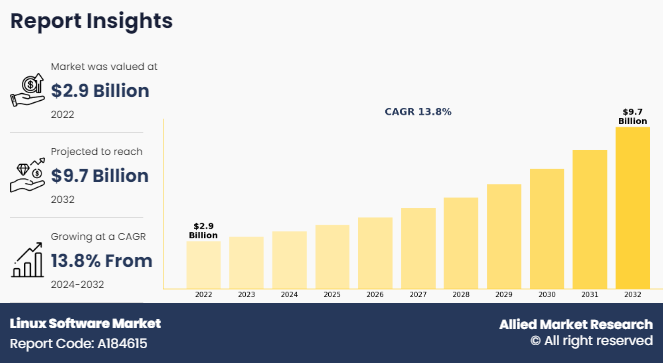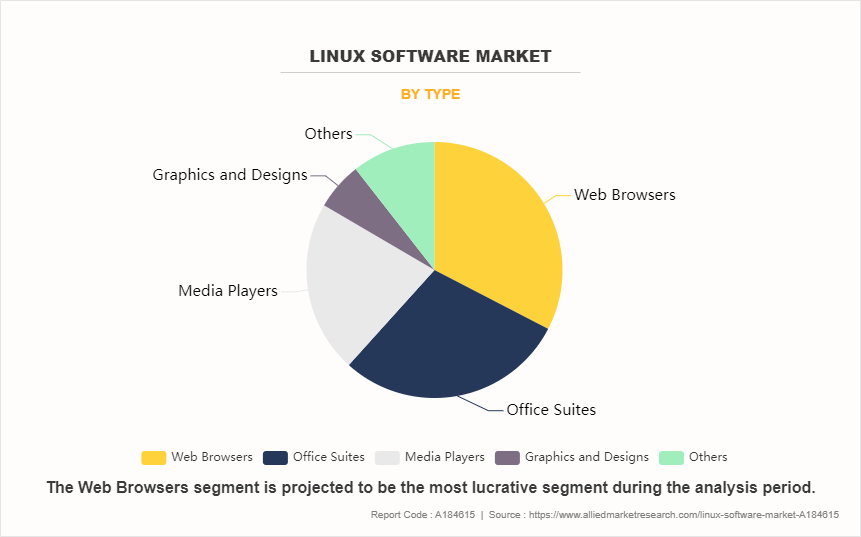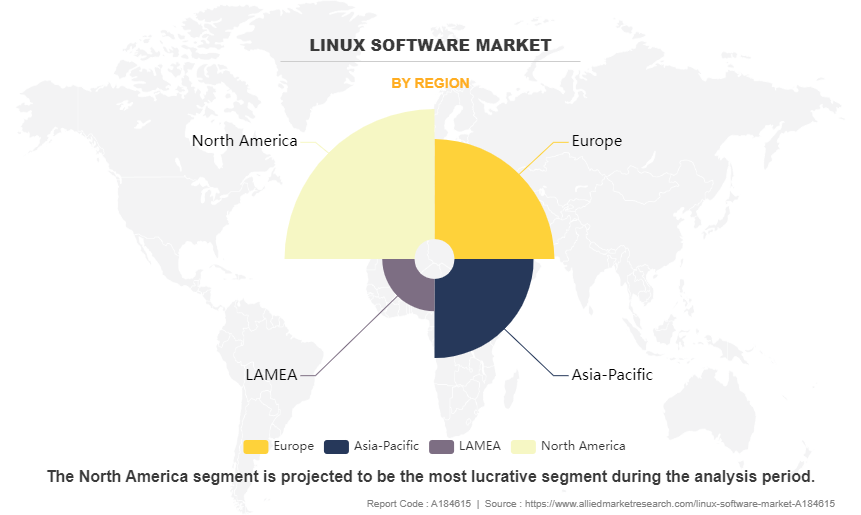Linux Software Market Insights, 2032
The global Linux software market was valued at $2,863.53 million in 2022, and is projected to reach $9,714.11 million by 2032, growing at a CAGR of 13.8% from 2024 to 2032.
Rise in concern regarding security features and stability of software, community support and innovation, and rise in need for cost effective and flexibility are the factors expected to propel the growth of the global Linux software market. Moreover, rise in demand for open-source solution in creative industries are expected to provide lucrative opportunities for the growth of the market during the forecast period. On the contrary, lack of availability of popular main stream software the growth of the Linux software market.

The Linux software market includes software products and solutions designed to run on the Linux operating system. Linux, an open-source operating system based on the Linux kernel, continues to increase its popularity and adoption across all industries and sectors due to its stability, security, flexibility, and cost-effectiveness. As a result, the Linux software market expanded and diversified, providing a wide range of applications, tools, and services customized to the changing demands of enterprises, developers, and individual consumers.
The Linux software market offers a wide range of software products and services, including operating system distributions (including Ubuntu, Fedora, and CentOS), productivity tools, development environments, server applications, security solutions, and cloud-based services. These products serve a variety of user bases, including individual users searching for desktop programs that are easy to use and enterprise clients in need of reliable server solutions.
In addition, reduced physical audits can be an issue and a major drawback due to loss of in-person interaction with the inventory. Therefore, these are some of the major factors limiting the Linux software market growth. On the contrary, developing software that can provide more features customized according to a firm’s needs and can easily fuse with the companies’ software is expected to open lucrative business opportunities for major players and new start-ups in the market in the coming years.
Key Takeaways:
By type, the basic web browser segment accounted for the largest Linux software market share in 2022.
By application, the personal segment accounted for the largest Linux software market share in 2022.
Region wise, North America generated the highest revenue in 2022.
Segment Review
The Linux software market is segmented into type, application, and region. By type, it is divided into web browser, office suites, media players, graphics & designs, and others. By application, the market is bifurcated into personal and commercial. Region-wise, it is analyzed across North America, Europe, Asia-Pacific, and LAMEA. .

One the basis of type, the web browser segment dominated the market share 2022 and, is expected to maintain its dominance during the linux software market forecast period, owing to the growing popularity of open-source browsers such as Google Chrome and Mozilla Firefox. This has led to rise in demand for Linux-compatible browser solutions that offer the same level of functionality and performance as their counterparts on other operating systems, which is further expected to propel the segment growth in the global market.
However, the office suite segment is expected to exhibit the highest growth during the forecast period, as the flexibility and customization options offered by Linux software allow users to modify their tools to suit their specific needs, providing a level of control and creativity, which is drives the segment growth in the Linux software market.

Region-wise, North America attained the highest growth in 2022. This is attributed to the rising popularity of Linux software in growing emphasis on cybersecurity and data privacy of the market in North America As North American organizations embrace digital transformation and migrate workloads to the cloud, Linux's flexibility and performance advantages have established the platform as an ideal option for deploying and managing cloud-native applications, virtual machines, and containerized workloads.. However, Asia-Pacific is expected to exhibit the highest growth during the forecast period owing to the rise of artificial intelligence (AI) and machine learning (ML) technologies in the Asia-Pacific region, which further contribute to the growth of global market.
Top Impacting Factors
Rise in Concern Regarding Security Features and Stability of Software
The heightened concern regarding security features and stability in the digital landscape is a key driver behind the growth of the Linux software market. In an era marked by rise in the number of cyber threats and data breaches, organizations and individuals are placing a greater emphasis on cybersecurity and data protection. Linux, known for its robust security architecture and stability, has emerged as a trusted choice for users seeking a secure and reliable operating system to safeguard their sensitive information and critical assets. Linux's strong security features, such as built-in access controls, secure file permissions, and regular security updates, contribute to its reputation as a secure platform for computing.
The open-source nature of Linux allows security vulnerabilities to be identified and patched quickly by the global community of developers, ensuring that the operating system remains resilient against emerging threats and vulnerabilities. This proactive approach to security maintenance instills confidence in users and organizations, driving the adoption of Linux as a secure and trustworthy operating system.
Furthermore, the stability of Linux is another compelling factor driving the market growth, particularly for businesses and enterprises that prioritize operational continuity and system reliability. Linux is renowned for its stability and uptime, with many organizations relying on it to power critical infrastructure, servers, and applications. The robust performance and reliability of Linux contribute to lower downtime, improved productivity, and reduced operational risks, making it an appealing choice for businesses seeking a stable and dependable computing platform.
As cybersecurity threats continue to evolve and pose significant risks to businesses and individuals, the security features and stability of Linux play a crucial role in driving its adoption across various industries and sectors. Organizations that prioritize data security, privacy, and system reliability are increasingly turning to Linux as a secure and stable operating system that can protect their assets and support their business operations effectively. The growing awareness of the importance of security and stability in the digital landscape is fueling the demand for Linux-based solutions, positioning Linux as a leading choice for users seeking a secure and reliable computing environment.
Community Support and Innovation
The open-source nature of Linux has fostered a vibrant and diverse community of developers, enthusiasts, and users who actively contribute to the development and improvement of the operating system. This collaborative approach to software development has created a dynamic ecosystem that thrives on innovation, creativity, and shared knowledge, driving the continuous evolution and enhancement of Linux as a robust and versatile platform. The Linux community plays a crucial role in providing support, resources, and expertise to users and organizations utilizing Linux-based solutions. With a global network of developers and contributors, users can access a wealth of community-driven forums, documentation, tutorials, and online resources that facilitate learning, troubleshooting, and collaboration.
The community support system enables users to seek assistance, share insights, and exchange ideas, creating a supportive environment that empowers individuals and organizations to maximize the potential of Linux for their diverse needs and applications.
Moreover, community-driven innovation is a key driver of the Linux software market growth and competitiveness. The collaborative nature of open-source development encourages experimentation, creativity, and the sharing of ideas, leading to the rapid development of new features, applications, and solutions within the Linux ecosystem. The collective efforts of the Linux community result in a wide range of innovative software offerings, tools, and technologies that address evolving user requirements, industry trends, and technological advancements, driving the adoption and popularity of Linux in various sectors and industries.
Competition Analysis:
Competitive analysis and profiles of the major players in the Linux software industry are Mozilla Foundation, Google LLC, Libreoffice, The Apache Software Foundation, Videolan, Kdenlive, Blender, Scribus, Shotcut and Rhythmbox. These major players have adopted various key development strategies such as business expansion, new product launches, and partnerships, which help to drive the growth of Linux software market globally.
Recent Developments in the Linux Software Industry:
In March 2024, Kdenlive launched Kdenlive 24.02, and its benefits are particularly noteworthy for Linux users, as improved Wayland support enhances the overall experience. The benefits of this upgrade are particularly noteworthy for Linux users, as improved Wayland support enhances the overall experience. Additionally, users on Windows, MacOS, and Linux will experience a substantial performance boost since Kdenlive now runs natively on DirectX, Metal, and Vulkan respectively, replacing the previous abstraction layer reliance on OpenGL and Angle, resulting in a more efficient and responsive application.
In July 2023, SUSE declared that it is investing more than $10 million to create, fork, and maintain as open-source, Red Hat Enterprise Linux (RHEL)-compatible distribution. The action comes after Red Hat decided to restrict RHEL code access to Red Hat clients in an effort to stop rebuilders from generating revenue via RHEL code without improving the program. According to Linux's fundamental license, the GPLv2, no restrictions can be placed on distributing the source code to those who've received the binaries. In the view of many in the open-source community, that's exactly what Red Hat has done.
Key Benefits for Stakeholders
- This report provides a quantitative analysis of the Linux software market size, segments, current trends, estimations, and dynamics of the linux software market analysis from 2022 to 2032 to identify the prevailing linux software market opportunities.
- The market research is offered along with information related to key drivers, restraints, and opportunities.
- Porter's five forces analysis highlights the potency of buyers and suppliers to enable stakeholders make profit-oriented business decisions and strengthen their supplier-buyer network.
- In-depth analysis of the linux software market segmentation assists to determine the prevailing market opportunities.
- Major countries in each region are mapped according to their revenue contribution to the global market.
- Market player positioning facilitates benchmarking and provides a clear understanding of the present position of the market players.
- The report includes the analysis of the regional as well as global linux software market trends, key players, market segments, application areas, Linux software market size and market growth strategies.
Linux Software Market Report Highlights
| Aspects | Details |
| Market Size By 2032 | USD 9.7 billion |
| Growth Rate | CAGR of 13.8% |
| Forecast period | 2022 - 2032 |
| Report Pages | 243 |
| By Type |
|
| By Applications |
|
| By Region |
|
| Key Market Players | Mozilla Foundation, The Apache Software Foundation, LibreOffice, Google LLC, VideoLAN, Kdenlive, Scribus, Shotcut, Rhythmbox, Blender |
Analyst Review
The Linux software market is a dynamic and fast evolving sector of the software industry, propelled by widespread Linux use and rise in demand for open-source solutions. Linux, recognized for its stability, security, and flexibility, emerged as a popular option for corporations, developers, and individual users looking for dependable and cost-effective software platforms. Linux is an open-source operating system, which has grown in popularity due to its flexibilities, stability, and community-driven development methodology. Flexibility and stability established Linux as the preferred alternative for consumers, companies, and organizations seeking dependable and adaptable software solutions. Rise in trend of cloud computing and virtualization technologies is an important factor driving the growth of the Linux software market. Linux's high performance, scalability, and compatibility with cloud environments make it an excellent choice for enterprises and developers seeking to capitalize on the benefits of cloud infrastructure. As more businesses shift their workloads to the cloud, the need for Linux-based software solutions is anticipated to continue to increase.
Moreover, rise in the number of Internet of Things (IoT) devices and the need for secure and stable software platforms have further propelled the growth of the Linux software market. Linux's strong security features, lightweight footprint, and ability to run on a wide range of hardware architectures make it well-suited for IoT applications. Developers and manufacturers are increasingly turning to Linux to power their connected devices, driving the expansion of the Linux software market. In addition, the large network of open-source software applications and tools available for Linux plays a significant role in market growth. Without using only proprietary software, developers and organizations can use this extensive software repository to build solutions customized to their needs. This flexibility and freedom to innovate made Linux a popular choice for a wide range of projects and applications.
Furthermore, rise in interest from government agencies, educational institutions, and enterprises in adopting open-source solutions has further fueled the growth of the Linux software market. Organizations are recognizing the benefits of using Linux-based software, such as reduced licensing costs, improved security, and greater control over their software stack. This trend is expected to drive growth in the Linux software market as more businesses and institutions embrace the advantages of open-source software.
For instance, in May 2023, oracle upgraded its Linux and enhanced the user experience across on-premises, cloud, and edge deployments, with a focus on operational consistency and improved efficiency, to accelerate time-to-market for critical infrastructure assets. Oracle Linux 9 update 2 and Oracle Linux 8 update 8 for the 64-bit Intel and AMD (x86_64) and 64-bit arm (aarch64) platforms are available.
The global Linux software market was valued at $2,863.53 million in 2022, and is projected to reach $ 9,714.11 million by 2032, growing at a CAGR of 13.8% from 2024 to 2032.
Rise in demand for open-source solution is the leading application of Linux Software Market.
Community support and innovation and rise in need for cost effective and flexibility are the upcoming trends of Linux Software Market in the world.
North America is the largest regional market for Linux Software.
Mozilla Foundation, Google LLC, Libreoffice, The Apache Software Foundation, Videolan, Kdenlive, Blender, Scribus, Shotcut and Rhythmbox are the top companies to hold the market share in Linux Software.
Loading Table Of Content...
Loading Research Methodology...



